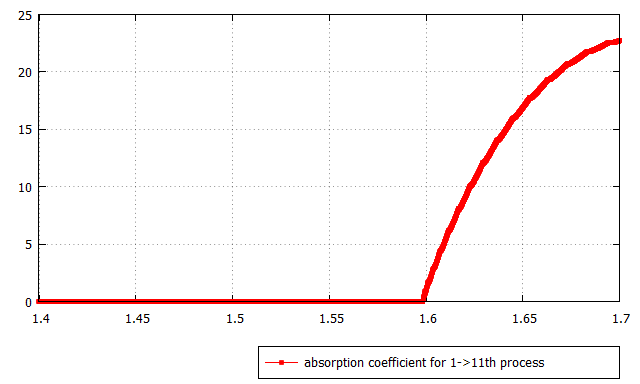User Tools
Sidebar
This is an old revision of the document!
Table of Contents
Optics tutorial (Simple)
This simple tutorial shows a simple simulation studies for absorption of semiconductor devices.
Structure
The structure is a simple AlGaAs quantum well which can be seen in the following figure.

<caption>The structure of the simulated device</caption>
The barriers are made from AlGaAs, and the well is GaAs.
Optics
The optics feature initialization looks like this:
optics{
name = "all"
debuglevel = 2
interband = $INTERBAND # yes
intraband = $INTRABAND # no
polarization{ name="y_plus_iz" re = [0,1,0] im = [0,0,1] }
polarization{ name="y_minus_iz" re = [0,1,0] im = [0,0,-1] }
output_transitions = $TRANSISITONS #yes
occupation_threshold = $MIN_OCCUPATION
energy_threshold = 1E-8
transition_threshold = $MIN_TRANSISTION
energy_min = $ENERGY_MIN
energy_max = $ENERGY_MAX
energy_resolution = $ENERGY_RESOLUTION
k_integration{
num_points = $NUM_INTEGRATION_KPOINTS
num_subpoints = $NUM_INTEGRATION_INTKPOINTS
symmetry = 1
relative_size = $RELATIVE_INTEGRATION_KSPACE
}
}
interband,intrabandInitalizes if intra/interband transitions should be calculated or not.polarizationdescribes the polarization direction of the electric field. (When there is an 'i' it means it is circulary polarized)output_transitionsCalculation of the transition matrix elements (yes/no)occupation_threshold,energy_threshold,transition_thresholdThe minimum value of the energy,
occupation and transition intensity of the transition which should be calculated.
energy_min,energy_maxBoundaries of the calculated energy spectra.energy_resolutionThe energy grid spacing of the calculated points in the energy space.k_integrationdefines the points for integrating in the k space
The output
Bandedges in the sample
After it has calculated the strain, it calculates the the bandedges of the structure which can be seen on the figure:

<caption> The bandedges in the sample Conduction band HH, and LH bands SO band </caption>
In the quantum well region it can be seen that the bandedge smaller, and the valence band edge is close to the fermi level. That is the reason, why the valence band is populated, and interband transition could happen.
Quantum Mechanics
From the bandedges the program calculates the wavefunctions, in each band which is definied in the line:
num_electrons=$NumE num_holes=$NumH
It means how many electron and hole states should be calculated.
The wavefunctons are plotted on the following figure:

<caption>The wavefunction probabilities for each band</caption>
Optics
Absorption
For each defined polarization the program calculates the transition matrix elements between the states (integration of the wavefunctions in k space). Then it calculates the absorption coefficient (1/mucm) per one transition (it should consider the population of the states). For example one absorption coefficient can be seen as a function of the energy of the incoming field:
<caption>The absorption coefficient between the 1st and the 11th eigenstate of the system as a function of energy</caption>
The overall absorption coefficient of the system is the sum of the partial absorption coefficients of each transition.
<caption>The overall absorption coefficient as a function of energy</caption>
Im($\epsilon$)
Its imaginary part of the permittivity (related to the conductivity) could be calculated from the absorption coefficient with the following formula if the absorption is small.
$\alpha= \frac{\omega}{n_r c} \cdot \frac{\epsilon_2}{\epsilon_0}$
The values of the imaginary part of the permittivity function is in the files imepsilon*.dat.
Transitions
The summary of the transitions have been saved in the “transitions_all.dat” files, together with the intensity, and the rate of the transition.


